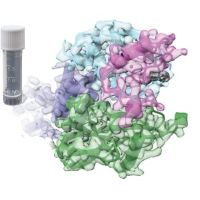Specification
| Description | Recombinant protein from the full-length sequence of Homo sapiens replication protein A2 (RPA2), transcript variant 1 (NM_002946). |
| Organism | Homo sapiens (Human) |
| Expression Host | Human Cells |
| Tag Info | His or DYKDDDDK. Please contact us if you need further information or require specific designed tag. |
| Purity | Greater than 90% by SDS-PAGE gel |
| Uniprot ID | P15927 |
| Entry Name | RFA2_HUMAN |
| Gene Names | RPA2 REPA2 RPA32 RPA34 |
| Alternative Gene Names | REPA2 RPA32 RPA34 |
| Alternative Protein Names | Replication protein A 32 kDa subunit (RP-A p32) (Replication factor A protein 2) (RF-A protein 2) (Replication protein A 34 kDa subunit) (RP-A p34) |
| Application | Antigens, Western, ELISA and other in vitro binding or in vivo functional assays, and protein-protein interaction studies; For research & development use only! |
| Buffer | Purified protein formulated in a sterile solution of PBS buffer, pH7.2, without any preservatives |
| Endotoxin | Endotoxin level is < 0.1 ng/µg of protein (<1EU /µg) |
| Length | 270 |
| Molecular Weight(Da) | 29247 |
| Protein Sequence | (The sequence of expressed protein may have some variation from the sequence shown below. Please contact us for the exact sequence.) MWNSGFESYGSSSYGGAGGYTQSPGGFGSPAPSQAEKKSRARAQHIVPCTISQLLSATLVDEVFRIGNVEISQVTIVGIIRHAEKAPTNIVYKIDDMTAAPMDVRQWVDTDDTSSENTVVPPETYVKVAGHLRSFQNKKSLVAFKIMPLEDMNEFTTHILEVINAHMVLSKANSQPSAGRAPISNPGMSEAGNFGGNSFMPANGLTVAQNQVLNLIKACPRPEGLNFQDLKNQLKHMSVSSIKQAVDFLSNEGHIYSTVDDDHFKSTDAE |
Background
| Function | FUNCTION: As part of the heterotrimeric replication protein A complex (RPA/RP-A), binds and stabilizes single-stranded DNA intermediates, that form during DNA replication or upon DNA stress. It prevents their reannealing and in parallel, recruits and activates different proteins and complexes involved in DNA metabolism. Thereby, it plays an essential role both in DNA replication and the cellular response to DNA damage. In the cellular response to DNA damage, the RPA complex controls DNA repair and DNA damage checkpoint activation. Through recruitment of ATRIP activates the ATR kinase a master regulator of the DNA damage response. It is required for the recruitment of the DNA double-strand break repair factors RAD51 and RAD52 to chromatin in response to DNA damage. Also recruits to sites of DNA damage proteins like XPA and XPG that are involved in nucleotide excision repair and is required for this mechanism of DNA repair. Plays also a role in base excision repair (BER) probably through interaction with UNG. Also recruits SMARCAL1/HARP, which is involved in replication fork restart, to sites of DNA damage. May also play a role in telomere maintenance. {ECO:0000269|PubMed:15205463, ECO:0000269|PubMed:17765923, ECO:0000269|PubMed:17959650, ECO:0000269|PubMed:19116208, ECO:0000269|PubMed:20154705, ECO:0000269|PubMed:21504906, ECO:0000269|PubMed:2406247, ECO:0000269|PubMed:24332808, ECO:0000269|PubMed:7697716, ECO:0000269|PubMed:7700386, ECO:0000269|PubMed:8702565, ECO:0000269|PubMed:9430682, ECO:0000269|PubMed:9765279}. |
| Pathway | |
| Protein Families | Replication factor A protein 2 family |
| Tissue Specificity |
QC Data
| Note | Please contact us for QC Data |
| Product Image (Reference Only) |  |

